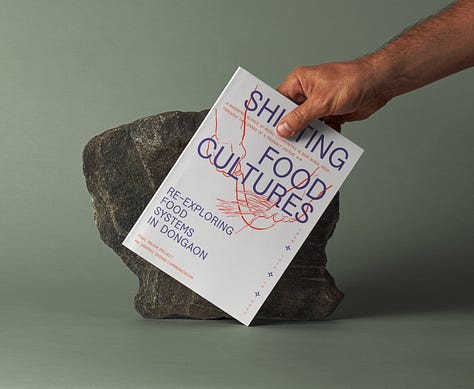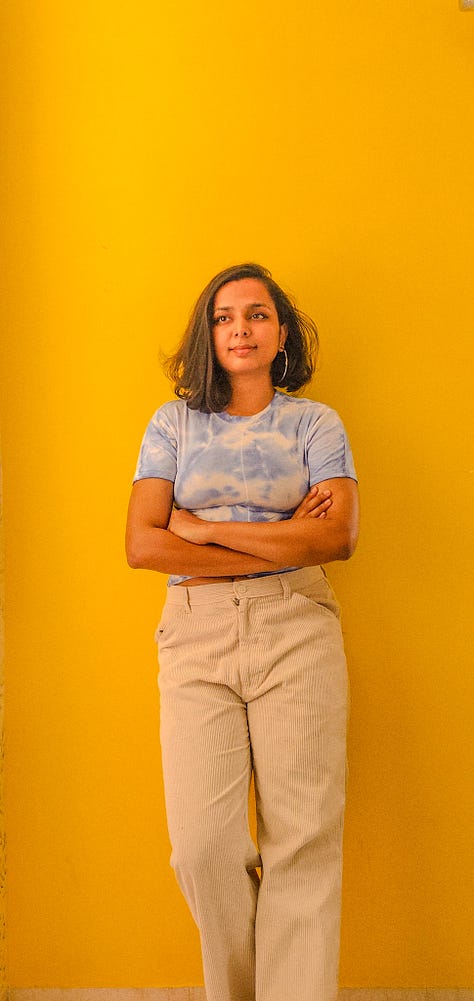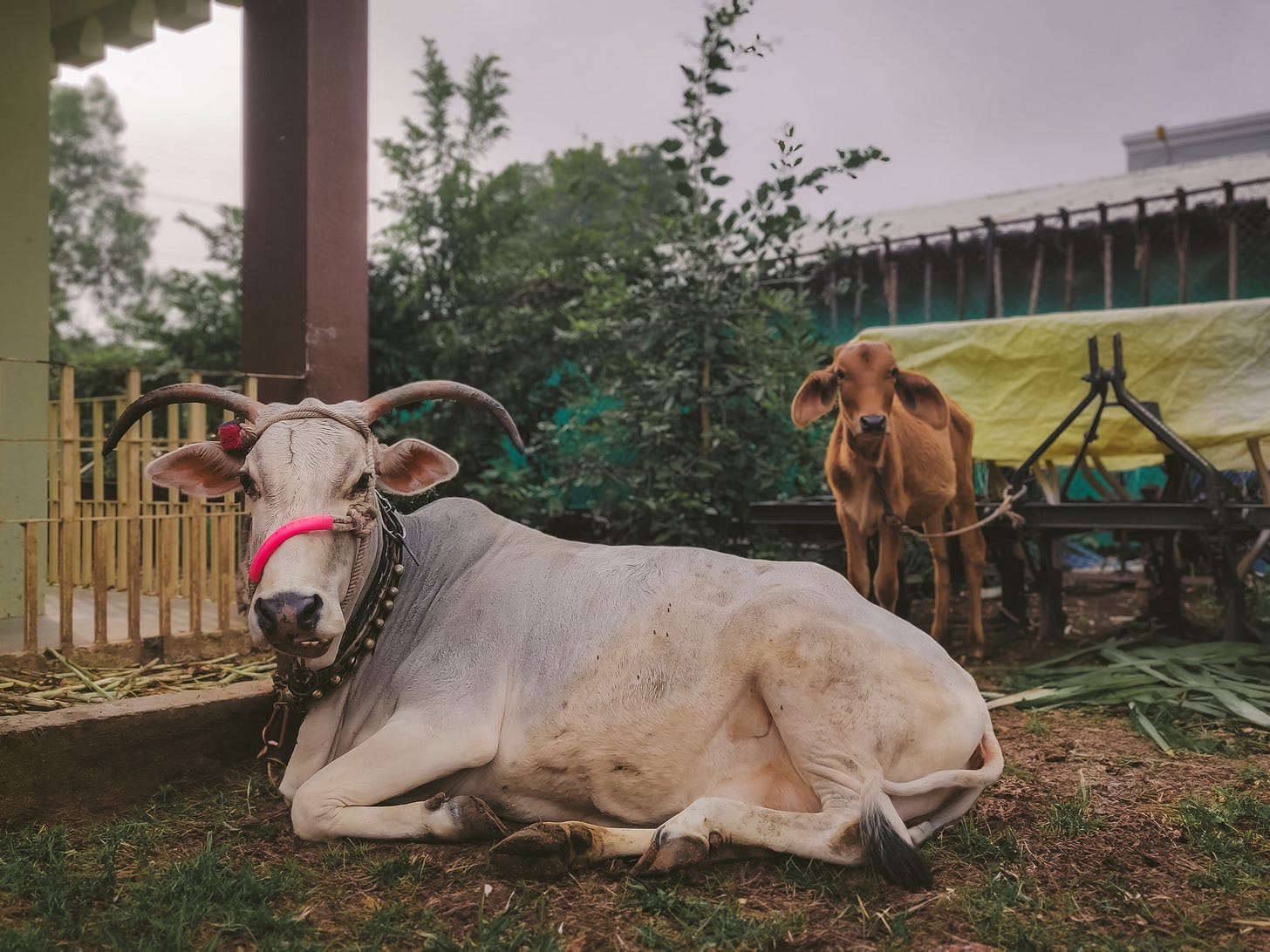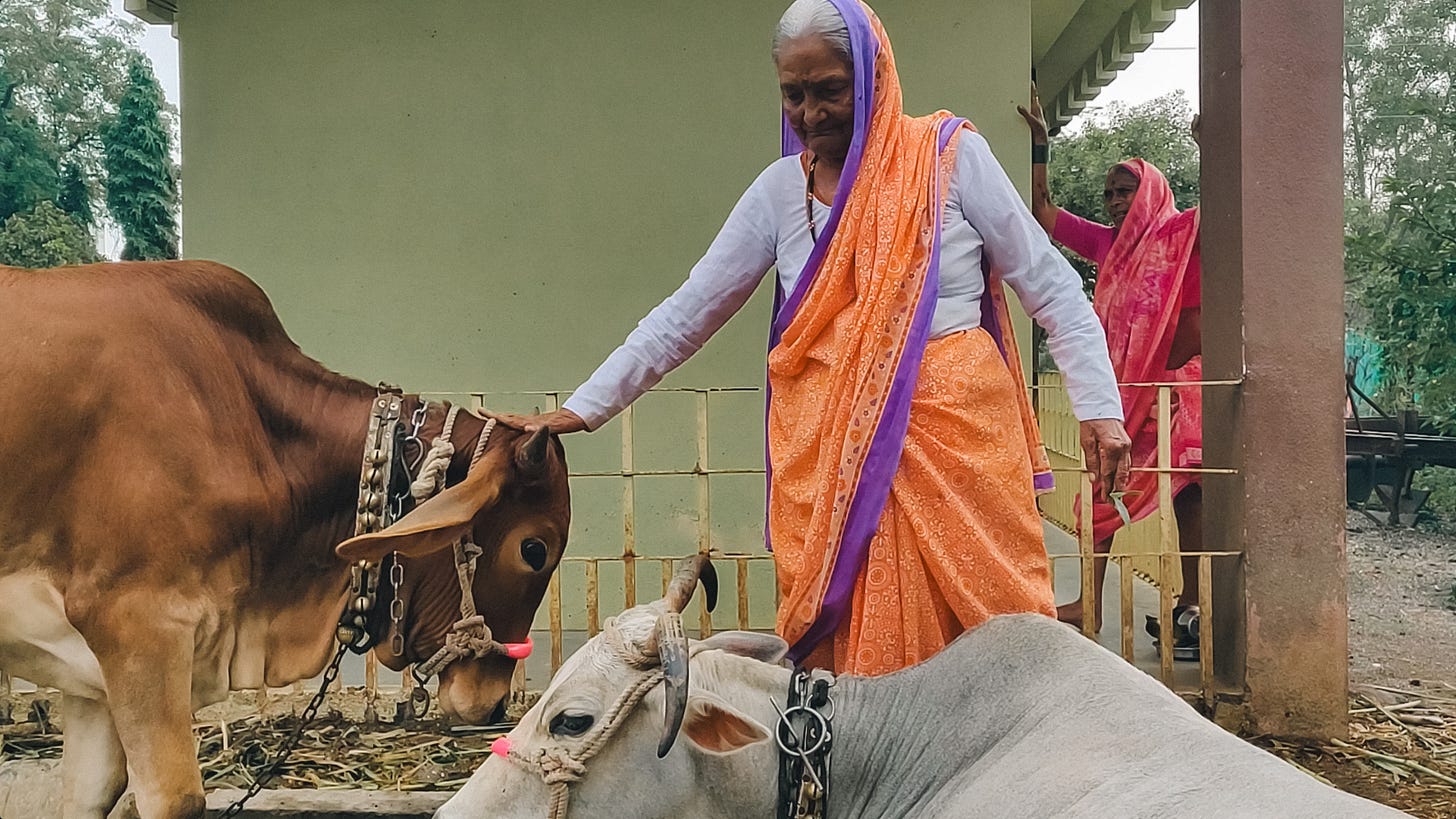"I am not just a consumer."
A farmer’s daughter, a designer and a business owner, Neeraja Dhorde on food systems, design interventions and ghee.
My first interaction with Neeraja’s work was when she was hosting Virtual Dinner Parties during the pandemic - I discovered the posters on social media and instantly got curious. Fast forward to 2023, I reached out to her when I moved to Bombay, hoping to find a like-minded friend and we instantaneously connected. Neeraja’s work much like her is honest, rooted in conviction and relatable. For ‘adjacent’, I interviewed her over a video call where (as you’ll read now) we talked about food, farming, design and women.
This is a part of a paid series.
Rini: Where did you grow up and do you have any food-related memories from that time?
Neeraja: I was born in Dongaon – a small village in Maharashtra, two hours away from Nasik and twenty minutes away from Shirdi. It lies between two districts Ahmednagar and Aurangabad and is often ignored by both district administrations. I grew up at the intersection of two districts and two cultures. I was born here and my parents always wanted me to get an urban education, away from Dongaon. So, they sent me to a boarding school in first grade and I have been away since then.
The food memories that connect me to Dongaon have always been related to my mum’s food - the traditional preparation that she, my grandmother and my different aunts used to make and still do. The practices that they carried forward and they got from their mums. I have always been curious about it. More than the taste of food, it has always been the nostalgia – the memories of childhood, the summer memories when mum used to make various kinds of papads and kurdai (fryums made by fermenting wheat). She used to wait for me and my sister to come back home for summer vacations to make these. It was almost a community activity where all my aunts came together and made these kurdais, vadas, papads and sundried them on the terrace of our home.



Rini: As a communication designer, your portfolio has a lot of food-related projects like The Common Table’s identity, Shifting Food Cultures and Virtual Dinner Party. Were you always interested in taking up food projects or did that just happen?
Neeraja: It just happened. Nothing was intentional until a point. When I was in London, finishing my Master’s degree in Communication design - the theme of my thesis was Speculative Futures. I just ended up working around food – my parents are farmers, and all my family is into food production, so it was subconsciously always there, I guess. But my relationship with food in general was always as a consumer. I never actually thought about where it comes from who the stakeholders are, how the systems work, what are the different food cultures or what could the future of food be. However, studying design and working on the thesis project pushed me to think about where I come from and what is my relationship with food as a designer. I understood that I am not just a consumer, I have known the process of food production and farming since I was a kid and it has been happening right in front of my eyes.
Then, coincidentally for good/bad COVID happened. My thesis project was about designing food-related tools for the future in which foods will change and accordingly, the tools with which you cook the food will have to evolve. I was working on that and suddenly, because of COVID, I had to come back home to Dongaon. I was disheartened and how. Although my course leader, Sadhna pushed me to think and observe about what is around me and build on that context. That is when I started to delve deeper into the farming cultures, agriculture and food systems in Dongaon. The project started taking a form and then I just attracted everything food-related around me for the next few [following] years.
Rini: What was your experience working with people who came from different food contexts?
Neeraja: It all started when I hosted the first session of The Virtual Dinner Party. We had people coming from various backgrounds/countries and working on various levels in the food systems. There were food designers, chefs, farmers, policymakers who attended the session. Working with The Common Table happened at the correct time, I was just done with my theses and was putting out posters for the next few sessions of VDP. Somehow Orlando came across one of these posts and got in touch. Our values aligned and we wanted to explore working together. I understood that The Common Table intended to reach a broad audience and delve deeper into a broader context of food. It just blew my mind that they were talking to policymakers, rural farmers, chefs, home cooks, cheese makers, and so many more people working with food. Their approach is not only theoretical but also design-centric and that inspired me. The platform is also relatable to everybody, and not just to the people who work with food or in the food industry. They look at food systems like pieces of a puzzle put together to cover different aspects of it – wild, education, kitchen, agriculture, policy, microbiome, and legacy. So these different parts come together and make this system. I loved visualising these categories for them. Translating these values into the visual language was extremely important and they were very much open to ideas and experimentation. This is where the collaboration of visual design and food publishing happened.
Rini: What are the processes and challenges as a fourth-generation farm entrepreneur of creating a value-first-quality-first brand?
Neeraja: I started working with The Common Table, and later with Sugar & Space a few years ago. After hosting The Virtual Dinner Parties by myself for a while, Jashan came up with the idea of including them as a part of the first issue of his publication - FDN. That was the time when I realised the power of design in the food systems because till that point my contribution was limited to making films, publications, and visually attractive posters. I hosted a few sessions of VDP in Dongaon where I spoke about the food cultures here, and native food practices like fermentation, sun drying etc. I sensed that there was a curiosity amongst the participants to experience a part of Dongaon and that encouraged me to start sending food items like ghee and butter that my mum made in our kitchen to various parts of the world so they could taste a bit of Dongaon.
These ghee jars that I used to send to people as presents slowly started turning into repeat orders and that is when we thought of building something out of it. That is how Dongaon Local was born. We have had a few cows at home and mum used to make ghee just for household consumption. It was just made to eat at home and that is how it is in multiple houses here in Dongaon. When the demand for the Ghee started increasing, I realised that I could not push them to make more ghee to fulfil it. We had limited resources and that was for a reason. We needed to work within that limitation. That is when I learnt to preserve this aspect of micro which in turn ensured the quality. When my mum or my aunts make ghee, they just make it in the same way in smaller batches as they make it for home consumption. We don’t keep inventories and big stocks of ghee. It’s always made to order in batches and hence takes time to deliver. I don’t know if it’s a good thing or a bad thing. We struggled a lot to keep up with the high demand when Dongaon Local was launched because we are a very small enterprise with limited resources and we wanted to keep it that way and embrace the micro aspect of it.
Coming to the second challenge - We have always had a patriarchal culture here in Dongaon–men control all the farming work and businesses and women work in the kitchens. The power dynamics were very different here. A lot of women producers of Dongaon Local were hesitant to let the male members of the family know about their work. The notion of a woman earning for herself is threatening to the men here and it was a challenge for us to navigate through this system because this is a women-run brand - all the producers are women who have similar stories to tell. We have now come a long way from there; however, to date, some of these women prefer to keep this from their husbands.
Another challenge was that in the initial phase, my parents did not understand the value of the work they did - there was an inferiority complex related to their occupation as farmers. It took me almost 2 years to make them understand the value of what they do. Also, keeping up with the traditional practices and staying away from the typical perception of what a brand is - was a significant aspect for us to bring into practice for Dongaon Local. Manojeet and Pranali from NYUCT helped me to understand what power I have in terms of building the perception of the brand. It does not have to be big, it does not have to be funded, a brand is something you create, who you are, how you tell your story, how you reach your audience and what your product is. As a designer, I have always understood that, but it’s different when it comes to building your brand. It is so much about telling your honest story, being transparent, owning up to what you have and presenting it to the world. If they want it, they will take it. That is how this brand story was created with NYUCT where we positioned ourselves as a micro-batch ghee brand. It is artisanal, made in the home kitchens the old traditional way with lots of love and care. It is traceable to the cow and exactly what she feeds upon. That is our story - small farms and big love!
As we are growing, there are more challenges incoming - like quality control and scaling. My mother’s method of making ghee is different from my aunt’s method who comes from a different family which has a different method of making ghee. When you taste these different batches of ghee you can tell the difference only if you understand the flavours – you can tell that one batch is grainier than the other, or one could be nuttier than the other batch. So positioning ourselves as an artisanal brand also gives us some space/discount to capture nuances in the flavours. We were able to embrace all of these nuances. We are honest with our audience, and with our customers and even today when I send a bottle of ghee to people, I always write a handwritten note where I specify who made that batch of ghee and from which variety of cow it is, if there are any storage instructions, or when it was made. That just helps us be transparent with our customers and allows them to be aware about what they are consuming and where it is coming from. This way we are trying to nurture what we have and embrace these challenges with all honesty and transparency.
Rini: When talking about context, women are purveyors of a lot of knowledge, traditional practices and carriers of food from one generation to another. What’s women's role in this context? And what do we as a community need to learn or learn to appreciate?
Neeraja: In the context of Dongaon, it is important to understand how these women are operating here. They have been carrying forward the traditions and skills - be it related to food or anything else, that they inherited from their mothers/grandmothers. They were always bound to apply these skills within their own homes, without attracting any eyes on them. When these women started working in their kitchens, doing what they always did, but also started earning money from it, the actual threat came in. The idea of a woman doing something for money here is radical, and is seen as a rebellion in some ways..the women are still scared to tell their husbands that they earn money, and that is heartbreaking. However, I am seeing that improvement.. I am seeing women feel a sense of power, overcoming the hurdle of how they are perceived and taking more control. It is impactful and that is what keeps me going. If you think of it as a business, we are not scaling vertically, it is more of horizontal growth. Apart from money, there are a lot of other things that we are gaining as a community.
It is equally about the empowerment of these women. My attempt has always been to make them understand and value their skills & feel empowered because it is a huge power they have. A very good example is of one of the women producers - she has not told her husband that she is working with us and that she is supporting her son’s education by funding it. She was hesitant to be a part of Dongaon Local but now she enjoys the process of making ghee, reaching a broader audience, and just the fact that someone sitting in Bombay, Bengaluru or Delhi is enjoying her ghee is very encouraging. I always make it a point to share feedback with them, which in turn encourages them and makes them feel good, they realise the power of their skills because they have never been outside of their households, kids or families. No one has appreciated them, and today there’s an urban audience coming back and saying that the ghee was nice and that they want more. I send these screenshots to them just to make them realise that what they are doing is huge. I am also growing and evolving with them and Dongaon Local as we move forward. It is amazing to witness the growth of the brand and the community from both lenses - as a visual designer who lives in Bombay with a full-time job and as a 4th generation farmer who is building something small yet high quality and traceable with her mother.
Rini: Any recommendations you’d like to share with our readers?
Neeraja: Speculative Everything by Anthony Dune and Fiona Raby
Go check out Dongaon Local’s website to know more.
This interview is part of a new series called "Adjacent,” where we document conversations, interviews and snippets of people in our community who don’t directly work in food, but their work influences food, culture, and eating in many ways.
Adjacent means next to something, neighbouring, the periphery of one thing almost merging with another. The goal of this series is to expand the literature, knowledge and ideas that exist in those intersecting spaces. We will talk to environmentalists, business owners, designers, workers, growers and educators who influence what we consume ( literally and figuratively).
This series will be accessible to paid subscribers. Please support the two-people team behind dhoop by paying for a monthly/yearly subscription of our newsletter. We promise to bring only valuable content to you.










